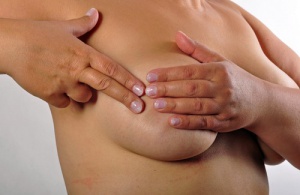How to Avoid Pain in Fibrocystic Breasts


Written and verified by the doctor Nelton Abdon Ramos Rojas
A sense of hardening and pain in the breasts, especially before the beginning of a menstrual cycle, is very common in adult women. In today’s article we’ll tell you all you need to know about how to avoid pain in fibrocystic breasts.
This discomfort is caused by what is known as “fibrocystic breast changes”. These can appear in breast tissue due to the actions of different hormones. It is believed that up to 60% of women between the ages of 30 and 50 could suffer from fibrocystic breasts.
Symptoms of fibrocystic breast changes
These are some of the most common symptoms among women who have fibrocystic breasts:
- When touching the breast, nodular areas can be felt. These will have wide-spread hardening or irregularities in the breast tissue (especially in the few days prior to menstruation).
- Pain and sensitivity in the breasts.
- Soft and mobile cysts full of liquid may also appear.
- Nipple secretions, either clear or lightly cloudy in color.
It is important to point out that if you notice nodules or any other irregularities in your breasts, you should consult a doctor. They will be able to perform the appropriate diagnostic testing. The doctor may send you for a mammogram, or an ultrasound mammogram, to rule out other illnesses. Since fibrocystic breast changes are so common, and present no greater health risks for women, physicians do not consider this to be an illness. However, many women look for ways to relieve the tension and pain of fibrocystic breasts. We’ll explain how you can.
Read more: Itchy or Painful Breasts: Treatment and Possible Causes
How to avoid pain with fibrocystic breasts
Reduce salt intake
Some people recommend reducing salt intake, or salty foods, so that the body doesn’t retain liquids. In theory, this could work to alleviate symptoms brought on by fibrocystic changes in the breasts. However, there are still no scientific tests that prove the efficiency of this method.
Avoid teas, coffee, and carbonated drinks
Beverages such as black tea, sodas, hot cocoa, and coffee all have one thing in common. They all contain substances from the same family, known as Methylxanthine. Some women claim that by avoiding these drinks, for at least a couple months, they experience relief from symptoms brought on by fibrocystic breast changes.
Read more: What are the Pros and Cons of Drinking Coffee?
Use a semi-orthopedic bra (corset)
Excessive compression of the breast tissue can cause more fibrous areas to form in the breast, thereby causing pain. That’s why, to relieve this discomfort, it’s important to use a suitable bra. The best types are ones that don’t have metal bars or wires in them. The cup will cover the entire breast. Specialists recommend only using bras that meet the following criteria:
- The band wrapping around the torso should be wide, and not too tight.
- There should be enough space to slip one finger easily between the breast and the cup of the bra.
- Straps should be wide, and never leave marks on the skin.
Several specialists also recommend removing bras to sleep. If you are large-chested, you can wear a cotton top, rather than a bra, when you go to bed. And lastly, always remember the importance of consulting a physician if you find any irregularity in your breasts, so as to rule out any potential illnesses.
All cited sources were thoroughly reviewed by our team to ensure their quality, reliability, currency, and validity. The bibliography of this article was considered reliable and of academic or scientific accuracy.
- Gallo Vallejo y otros. Mastopatía fibroquística. Aspectos controvertidos. Clínica e Investigación en Ginecología y Obstetricia. Vol 40, Nº 6, pp 269-276. 2013. DOI: 10.1016/j.gine.2013.02.006
This text is provided for informational purposes only and does not replace consultation with a professional. If in doubt, consult your specialist.








